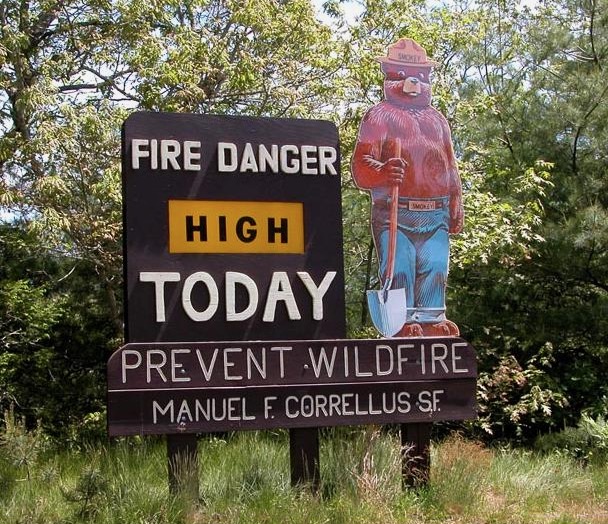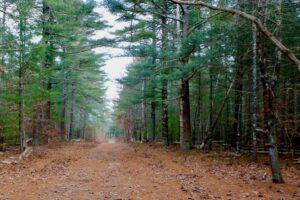
Learn about wildfire risk and take action today
Mardi Moran is a member of Citizens Against Wildfire, a volunteer group of Vineyarders who are working together to increase community awareness of the wildfire threat on the Island.
The risk of wildfires on Martha’s Vineyard comes just behind flooding as the biggest risk the Island faces (see our local Hazard Mitigation Plans from the MV Commission here). We look at other sections of the country with horror as we see so much catastrophic destruction and damage from wildfires, and need to take action here at home to prevent our island from suffering the same fate.
If one looks around, we can see dead wood, not only in the 5,000-acre State Forest, in the Land Bank and Conservancy properties, but in the woods that we drive past daily and in the neighborhoods where we live. Island Fire Chiefs tell us that we don’t have enough equipment to properly fight a major fire and that the Volunteer Fire Force is diminished because individuals have to find additional jobs to make ends meet on the Island.
There are parts of the State Forest that haven’t burned in 65 to 80 years. Trees were planted that are not conducive to our ecosystem and have died but remain in the forest. We have seven to ten tons of flammable scrub oak, huckleberry and blueberry bushes in the State Forest? that are a danger.
Jo-Ann Taylor, the past Coastal Planner for the Martha’s Vineyard Commission stated: “We live in a land that has always depended on fire to maintain the proper habitat. We are not immune to having a bad wildfire. The risk is heightened by changes in climate that now deliver summer rain in heavy storms dispersed between short-term droughts.”
Adam Mouw, a graduate student at UMass, was stationed in our State Forest in the Summer of 1998. An article that year in UMass Magazine about his research stated:
 “A cleansing fire has not swept through this landscape for seventy years, and that’s created a literal tinderbox on an island where state land butts up against private property now thick with summer homes and permanent residences. By Mouw’s calculation, a fire that struck today would burn hot and fast, fanning out a mile wide and burning 664 acres within an hour and a half. The goal is to figure out what needs to occur to protect the environment, and what needs to occur to preserve people’s lives and property. In this case, these goals are fairly close together.”
“A cleansing fire has not swept through this landscape for seventy years, and that’s created a literal tinderbox on an island where state land butts up against private property now thick with summer homes and permanent residences. By Mouw’s calculation, a fire that struck today would burn hot and fast, fanning out a mile wide and burning 664 acres within an hour and a half. The goal is to figure out what needs to occur to protect the environment, and what needs to occur to preserve people’s lives and property. In this case, these goals are fairly close together.”
This was written twenty-two years ago. The fire hazards from our changing climate have only made the situation worse in the time that has passed since then. How dire is the situation today?
We realize as we watch the news how many different ways that fires have started in other parts of the country: carelessness, lightening, drought, etc. Imagine what we would do if a major fire were to occur. The SSA couldn’t handle evacuating us. How many beaches can we run to?
Thanks to the Martha’s Vineyard Commission, the Island has received a grant that will pay 75% of the cost of developing a wild fire management plan. What we need as well is a realization by our community that this is a danger we must all take seriously and work together to deal with it effectively.
Individual landowners, neighborhood groups, road associations, conservancy groups and the State, etc. must take responsibility for reducing forest fuels on their land. Working together, we can deal with this issue and keep our island and each other safe.
– Mardi Moran, Citizens Against Wildfire, December 2020
For more information about wildfire risk on the island, please see https://www.mvcommission.org/drought-and-wildfire
Take action on this issue in your own backyard. Find out how on the Island Fire Safety card.

